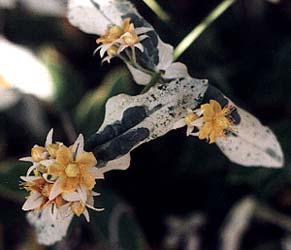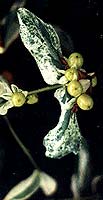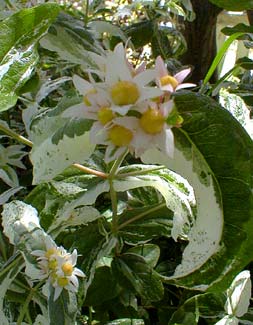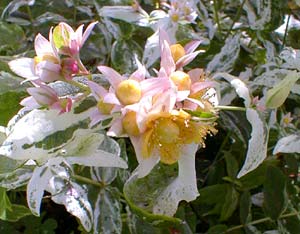 | |
|
O bitter herb, Forgetfulness, I search for you in vain; You are the only growing thing Can take away my pain. When I was young, this bitter herb Grew wild on every hill; I should have plucked a store of it, And kept it by me still. I hunt through all the meadows Where once I wandered free, But the rare herb, Forgetfulness, It hides away from me. O bitter herb, Forgetfulness, Where is your drowsy breath? Oh, can it be your seed has blown Far as the Vales of Death? -The Bitter Herb | |
'Glacier'
Saint John's Wort or Tutsan;
aka, Variegated Parkleaves
Though frequently listed as needing "sun to part shade" I saw a huge healthy patch of Saint John's Wort growing in fairly deep shade so tried to duplicate that environment for two species (three varieties). All did awfully well even in a shadier spot than usually recommended, & 'Glacier' has done awesomely well.
Here on Puget Sound at any rate, Hypericum androsaemon 'Glacier' bushes out & blooms intensely in a shade-garden, ours being underneath a Japanese maple & an elderly choke cherry tree. Another grows underneath a 'Loder's White' Rhododendron.
Plus there are self-seeded youngsters that selected their own locations, mostly in bright shade. It self-seeds much more insistantly than any of our other species of Saint John's Wort, not least because it produces the highest number of fruits, though I would not consider it invasive (though the species has become an invasive pest in parts of Australia & a few other places in the world).
The seedlings grow true to the parent, green foliage strikingly streaked with white. They transplant easily if they self-select an inappropriate location, & they make good container-plants to keep around until they can be given away as gifts.
 For shade-adaptability, our two varieties of H. moseranum in comparison to 'Glacier' would have bloomed lots better in a sunnier spot. So while I'd say that genus overall tolerates more shade than usually admitted, 'Glacier' in particularly actually thrives & is in top form when placed in a shady or semi-shady location; whereas, unless persistantly moist, full sun can cause the leaves to brown & the flowers to be exhausted in a matter of hours; with a little shade, it is drought-hardy without injury to its appearance; indeed, it suffers droughtiness much more gracefully than it would poorly draining, clayey, or overly compacted soil, being susceptible to root-rot if too wet in winter.
For shade-adaptability, our two varieties of H. moseranum in comparison to 'Glacier' would have bloomed lots better in a sunnier spot. So while I'd say that genus overall tolerates more shade than usually admitted, 'Glacier' in particularly actually thrives & is in top form when placed in a shady or semi-shady location; whereas, unless persistantly moist, full sun can cause the leaves to brown & the flowers to be exhausted in a matter of hours; with a little shade, it is drought-hardy without injury to its appearance; indeed, it suffers droughtiness much more gracefully than it would poorly draining, clayey, or overly compacted soil, being susceptible to root-rot if too wet in winter.The brown-tip I've seen on the leaves of specimens in full sun does not mar the beauty of ours in partial shaded, yet there is no lessoning of its flowering power & fruiting power. The issue of brown-tipping in full sun does not much effect the wild species as it does this variegated form.
'Glacier' is my favorite St John's Wort of any I have ever seen anywhere, a truly remarkable little shrub with those variegated stripy leaves, clusters of white-sepaled yellow-petalled flowers, & a very colorful fruit that starts yellow to green & ripens to red then purple then shiny black by Autumn, shrivelling like raisens by mid-autumn or early winter.
H. moseranum blooms for us until deep into winter, & a hybrid cultivar called H. 'Hidcote' likewise blooms Summer & Autumn very pleasingly even in bright shade. H. calycinum or Aaron's Beard is the most dramatically sun-hardy & drought-hardy with large impressive yellow flowers; we never tested it for shade, but since the hybrid 'Hidcote' is related to H. calycinum, I suspect it too would flower well in partial shade.
H. a. 'Glacier' by comparison to 'Hidcote' & H. moseranum does not have rebloom so late in the year, but even after its flower petals have gone, there are petal-shaped bases for the flowers which themselves look like pale greenish-white flowers, retained long after the real petals have fallen; indeed, these false-blossoms last the rest of the winter. Not to mention the addition of highly decorative berries that can persist to year's end.
It is semi-evergreen in our climate, but will be more deciduous in chillier climates. It requires late-winter or early-spring pruning to bloom its best come late spring & summer, & in chillier zones will need more pruning additionally because of winter injury to some of the limbs. Even if the entire subshrub is damaged & needs to be cut away, the roots will be fine, & it will persist happily year after year.
 A July 2001 photo of 'Glacier' is shown first at the top of this page, in full flower with dark green leaves that look almost painted over with white. It is very exciting to watch this shrublet go through its seasonal changes. An August 2002 photo of the berries while still yellow-green is shown in the second photo. You can view additional portraits (from 2003 & 2004) of the fruits when they turn purple & then black, on the 'Glacier' St John's Wort Page of the Berries Gallery.
A July 2001 photo of 'Glacier' is shown first at the top of this page, in full flower with dark green leaves that look almost painted over with white. It is very exciting to watch this shrublet go through its seasonal changes. An August 2002 photo of the berries while still yellow-green is shown in the second photo. You can view additional portraits (from 2003 & 2004) of the fruits when they turn purple & then black, on the 'Glacier' St John's Wort Page of the Berries Gallery.The third picture, of a cluster of blossoms, was snapped June 2003. The fourth shot taken about the same time highlights some of the pink that occurs around the backs of the flowers. By its third year in the garden it was over three feet tall & four feet wide. Though it had rarely been pruned in all that time, it remained relatively compact compared to some rangier varieties of St. John's Wort, the others needing annual pruning to stay pleasant. In colder areas 'Glacier' might have some winter damage needing trimmed away in spring, but in our mild seasons it very nearly becomes a woody shrub as it ages.
The species per se is not variegated like 'Glacier' but they are otherwise pretty much identical in behavior, the wild form being hardier still, especially if in droughty full sun. In its native England & Europe, it is often called Tutsan rather than Saint John's Wort. This is an English corruption of its French folkname, toutesaine, which can be translated "entirely healthy," either because the plant itself is so hardy, or because of a belief in its health benefits as a medicinal herb. The leaves were ground up to make a skin salve. The berries though inedible are not so toxic as to be a great danger, & were traditionally reduced to a paste taken internally as a diuretic.
Saint John's Wort was traditionally thought to scare away evil demons if you hung it over doors & windows, just like garlic scares vampires. Today superstitions about it persist because alternative medicine quackpots claim it cures AIDS & cancer & all sorts of things it cannot do, & many people take it as a "natural" downer & alternative to street drugs, self-medicating for depression or stress.
Claims of benefits for AIDS patients are especially appalling since the reality is that St John's Wort deters the benefits of AIDS drugs & will hasten the progression from HIV to full-blown AIDS resulting in early death.
Even its value for treating depression is either questionable or unpredictable. Some studies especially out of Germany (such as a Humboldt University Clinic of Psychiatry study by Uebelhack et al, 2004, & several other) do suggest medical grade Hypericum extract (not the crud available in American health food stores) benefits users who never in the first place met the criteria of serious clinical depression. The general attitude in Germany is that it is a suitable supplemental treatment for mild to moderate depression, but of little or no value for serious depression.
In the better-constructed double-blind studies conducted in the United States by the National Institute of Health, it was discovered that for individuals suffering clinical depression, St. John's Wort had no value, although possible value for minor & transient depression was not ruled out. Vendors cling to this last possibility, but the independent research has indicated so little promise that the vendors have had to resort to arranging their own studies.
The most promising doubleblind study was conducted in Germany by Dr. Willmar Schwabe Pharmaceuticals, & published in the British Medical Journal February 2005. This study set out to prove that the researchers' own "patented & unique standardized extract" of H. perforatum had the efficacy of Paxil or Paroxetine. The conflict-of-interest study not only "proved" their product was the equal of a Paxil, but the researchers went on to say that as many as 25% of women & 12% of men would benefit by the purchase & use of their patent-protected product. Note they are not recommending St. John's Wort generally, but exclusively their own product. "Jadies & Lentelmen! Nothing works but Dr. Willmar Schwab's Patented & Unique Snake Oil, er, St John's Wort!"
Dr. Willmar Schwabe Pharmaceuticals is Germany's leading phytomedication manufacturer, & their research is responsible for a lion's share of the best-case findings for products they sell. The fanatical recommendations for selling a product to as much of the public as is feasible renders cartoon-like the pretense of objectivity in arranging randomized doubleblind science, even though their Press Release in favor of their own product scored them thousands of blissful newspaper articles world-wide. Reporters universally failed to note that the company's conflict of interest in that their chief goal is maximizing sales of patented herbal remedies; genuinely independent research provides less hopeful evidence.
The Schwabe study repeated a common problem with the best-case studies in that it does not with any clarity distinguish between real clinical depression & the kind of mild depression one might feel after one's pet gerbil dies. By assuming that up 25% of women & 12% are qualified, they intentionally fail to focus on clinical depression. The Schwabe study also had no placebo group, so even if self-interest hadn't skewed results in order to show their product was as useful as Paxil (for people who might not actually be clinically depressed), such a finding could indicate that the patented extract & the Paxil were equally worthless rather than equally effective for the poorly-selected medicated groups.
Lacking a third placebo group was an intential fault in the study, to improve the odds of justifying the glowy Press Release ad copy they distributed as a direct adjunct to their "research." In the United States, Schwabe is promoted by American Botanical Council, a manufacturer- & vendor-membership organization that like Schwabe itself attempts to appear scientific when they are a promotional organization exclusively, & would never reveal any "fact" at odds with retail interests. In the P-R wars, actual science cannot compete with this degree of commerce, & the public ends up ill-informed.
Yet imbedded even in the Schwabe research are all sorts of subtle disclaimers that are not highlighted by any pop-article spun out of the research. Buried in the study is Schwabe's admission that their "patented & unique" product was safe & beneficial for "mild to moderate" depression, not for chronic or clinical depression, & even "moderate depression" by their definitioin appears to be synonymous with "melancholy & related depressive states." The evasiveness of the conclusions condemns the research, but the ad-hype value is maximized. The murkiness of their definitions permitted Schwabe to claim "most previous studies," like their own, show efficacy. In reality "most" previous studies show efficacy equal to that of a placebo.
Schwabe's claim that "most" of the research agrees with theirs is true in this context: It is true that clinically, chronically depressed individuals are not benifited by St John's Wort, & even the slanted Schwabe research does not actually suggest otherwise. But it is not impossible that people who are temporarily & mildly depressed, who would work their way out of it whether or not treated with anything at all, will in fact feel better after using just such a product, &/or a placebo posing as the product. If Schwabe's study & the studies collectively were fully credited, all they really show is that the same mildly or temporarily depressed group can benefit equally by a placebo, by Paxil, or by St. John's Wort. From this I would say that, at most, a great many people on Paxil who are only mildly or transiently depressed should not be on it, since St John's Wort or a placebo is the most they require. Unfortunately the press releases & pop articles do strive to muddy these realities, & intentionally give the impression that a prescription medication for severe depression might be no more valuable than an herb or a placebo.
The German government is one of the few to have regulated the herbal industry to the point that the products do meet a minimal requirement for pharmaceutical grade extracts, rather than for "food supplements" as in the United States where the available products don't have to be anything more than edible. Yet the German government has done nothing whatsoever to insure that the research is done independently rather than by vested interests.
A comparatively small percentage of more-or-less honest herbalists do always suggest that St. John's Wort will assist minor depression, but is not recommended for serious or severe depression. The Schwabe study may, alas, induce even the few honest vendors to believe they can now overstate the value of their herbs.
 Even were standardized pharmaceutical grade extracts more valuable than seems to be the case, the powdered or liquescent St John's Wort available in the United States from misnomered Health Food Stores has little to no drug value because that stuff is made out of dried leaves, twigs, & all the garden-rubbly non-medicinal parts of the plant, which is what "100% St John's Wort" means from hoodwinking herb sellers profiting off gullible hypochondriacs. That at least means these products, lacking any degree of potency, are not apt to cause serious side-effects, since it has little to zero active ingredient.
Even were standardized pharmaceutical grade extracts more valuable than seems to be the case, the powdered or liquescent St John's Wort available in the United States from misnomered Health Food Stores has little to no drug value because that stuff is made out of dried leaves, twigs, & all the garden-rubbly non-medicinal parts of the plant, which is what "100% St John's Wort" means from hoodwinking herb sellers profiting off gullible hypochondriacs. That at least means these products, lacking any degree of potency, are not apt to cause serious side-effects, since it has little to zero active ingredient.But people who have access to pharmaceutical grade extracts, or who harvest the blossoms & berries fresh for medicinal use, can introduce enough hypoericin & pseudohypericin to their systems to interfer with the function of prescribed drugs, so that it can harm health in exchange for what is often little more than an illusory placebo benefit.
St John's Wort should be regarded as a potentially strongly medicinal plant with dangerously toxic side-effects if harvested fresh, but a useless placebo of low toxicity if purchased as a healthfood store product. Anyone who does experiment with home remedies should in all cases inform their family physician, since St. John's Wort interfers with the effectiveness of prescription drugs.